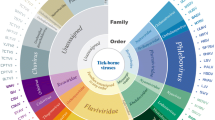Summary
There are various arthropods (e.g. insects, chiggers, mites, ticks) that take one or more blood meals on terrestrial vertebrates in the course of their lifetime. Among them are ixodid ticks (Acari, Ixodidae), all of which are obligately hematophagous. Their parasitic lifestyle predestines them to act as transmitters or vectors of microparasites, often pathogenic to humans and/or domestic animals. The list of ixodid tick-borne pathogens is long, encompassing viruses, bacteria, protozoans, and nematodes. The present mini-review gives a brief overview of the most relevant biological attributes that make ixodid ticks very efficient vectors compared with other hematophagous arthropod taxa.

Similar content being viewed by others
References
Pavlovsky EN. On the natural focality of infectious and parasitic diseases. Vestn Akad Nauk Sssr. 1939;10:98–108. in Russian.
Pavlovsky EN. Natural nidality of transmissible diseases with special reference to the landscape epidemiology of zooanthroponoses. Champaign: University of Illinois Press; 1966. First published in Russian in 1964. Moscow, Leningrad: Nauka.
Zlobin VI, Pogodina VV, Kahl O. A brief history of the discovery of tick-borne encephalitis virus in the late 1930s (based on reminiscences of members of the expeditions, their colleagues, and relatives). Ticks Tick Borne Dis. 2017;8(6):813–20.
Gern L, Siegenthaler M, Hu CM, et al. Borrelia burgdorferi in rodents (Apodemus flavicollis and A. sylvaticus): duration and enhancement of infectivity for Ixodes ricinus ticks. Eur J Epidemiol. 1994;10(1):75–80.
Labuda M, Austyn JM, Zuffova E, Kožuch O, Fuchsberger N, Lysy J, Nuttall PA. Importance of localized skin infection in tick-borne encephalitis virus transmission. Virology. 1996;219:357–66.
Dietz K. The estimation of the basic reproduction number for infectious diseases. Stat Methods Med Res. 1993;2(1):23–41.
Kahl O, Gern L, Eisen L, Lane RS. Chapter 2. Ecological research on Borrelia burgdorferi sensu lato: terminology and methodological pitfalls. In: Gray JS, Kahl O, Lane RS, Stanek G, editors. Lyme borreliosis: biology, epidemiology and control. London: CABI; 2002. pp. 29–46.
Balashov Y. Bloodsucking ticks (Ixodoidea), vectors of disease to man and animals. Akad Nauk SSSR, Zool. Inst. Leningrad; 1967. Entomol Soc Am. 1972;8:161–376. in Russian.
Sonenshine DS. Biology of ticks. Vol. 1. New York: Oxford University Press; 1991.
Anderson JM, Sonenshine DS, Valenzuela JG. Exploring the mialome of ticks: an annotated catalogue of midgut transcripts from the hard tick, Dermacentor variabilis (Acari: Ixodidae). BMC Genomics. 2008;9:552.
Sonenshine DS, Hynes WL, Ceraul SM, et al. Host blood proteins and peptides in the midgut of the tick Dermacentor variabilis contribute to bacterial control. Exp Appl Acarol. 2005;36:207–23. cited from Sonenshine and Anderson, 2014.
Kahl O. Investigations on the water balance of ticks (Acari, Ixodoidea) in the course of their postembryonic development with special reference to active water vapour uptake of the engorged phases. Germany: Free University of Berlin; 1989. In German. Doctoral Thesis.
Sonenshine DS, Anderson JM. Chapter 6: mouthparts and digestive system. In: Sonenshine DS, Roe RM, editors. Biology of ticks. 2nd ed. Vol. 1. New York: Oxford University Press; 2014. pp. 122–62.
Lees AD. Cloride regulation and the function of the coxal gland in ticks. Parasitology. 1946;37(3–4):172–84.
Kitaoka S. Physiological and ecological studies on some ticks. V. Nitrogen and iron excretion and amount of bloodmeal ingested during the blood sucking process in the tick. Natl Inst Anim Health Q (Tokyo). 1961;1:96–104.
Gregson JD. Observations on the movement of fluids in the vicinity of the mouthparts of naturally feeding Dermacentor andersoni Stiles. Parasitology. 1967;57(1):1–8.
Tatchell RJ. The ionic regulatory role of the salivary secretion of the cattle tick Boophilus microplus. J Insect Physiol. 1969;15(8):1421–30.
Kaufman WR, Sauer JR. Chapter 7: ion and water balance in feeding ticks: mechanisms of tick excretion. In: Obenchain FD, Galun R, editors. Physiology of ticks. Oxford: Pergamon; 1982. pp. 213–44.
Lees AD. The role of cuticle growth in the feeding process of ticks. Proc Zool Soc London. 1952;121:759–72.
Hackman RH, Filshie BK. Chapter 1: the tick cuticle. In: Obenchain FD, Galun R, editors. Physiology of ticks. Oxford: Pergamon; 1982. pp. 1–42.
Kahl O, Hoff R, Knülle W. Gross morphological changes in the salivary glands of Ixodes ricinus (Acari: Ixodidae) between bloodmeals in relation to active uptake of atmospheric water. Exp Appl Acarol. 1990;9:239–58.
Belozerov VN. Chapter 13: diapause and biological rhythms in ticks. In: Obenchain FD, Galun R, editors. Physiology of ticks. Oxford: Pergamon; 1982. pp. 469–500.
Gray JS, Kahl O, Lane RS, et al. Diapause in ticks of the medically important Ixodes ricinus species complex. Ticks Tick Borne Dis. 2016;7(5):992–1003.
Randolph S. The relative contribution of transovarial and transstadial transmission to the maintenance of tick-borne diseases. In: Axford JS, Rees DHE, editors. Lyme borreliosis. New York: Plenum; 1994. pp. 131–2.
Chunikhin SP, Stefuktina LF, Korolev MB, et al. Sexual transmission of the tick-borne encephalitis virus in ixodid ticks (Ixodidae). Parazitologiia. 1983;17(3):214–7. in Russian.
Randolph S. Epidemiological consequences of the ecological physiology of ticks. Adv In Insect Phys. 2009;37:297–339.
Acknowledgements
I appreciate useful discussions with Jeremy Gray (Dublin) and Hans Dautel (Berlin).
Funding
tick-radar GmbH has received support from Pfizer Deutschland GmbH.
Author information
Authors and Affiliations
Corresponding author
Ethics declarations
Conflict of interest
O. Kahl is an unpaid member of the ESGBOR steering committee, the ESCMID study group for Lyme borreliosis.
Rights and permissions
About this article
Cite this article
Kahl, O. Hard ticks as vectors—some basic issues. Wien Klin Wochenschr 130, 479–483 (2018). https://doi.org/10.1007/s00508-018-1360-x
Received:
Accepted:
Published:
Issue Date:
DOI: https://doi.org/10.1007/s00508-018-1360-x




